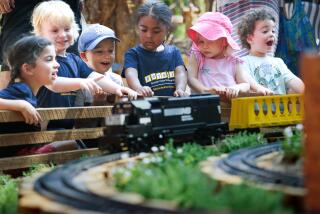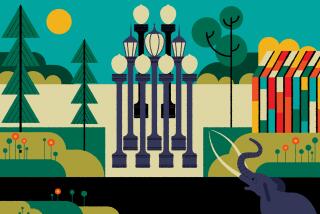Baltimore’s B&O; Railroad Museum Picks Up Steam
- Share via
BALTIMORE — The handsome circular building, which looks like it might house a gigantic merry-go-round, is surrounded by an incredible assortment of colorful trains. It might seem that such a surrealistic mix of equipment, outside such a grand structure, could only exist on a model railroad layout. But these are real trains and a real building: the B&O; Railroad Museum.
More locomotives and rail cars are inside the 107-year-old railroad roundhouse. Even more trains, including several alien-looking work cars, are in the yard behind it.
The B&O; Railroad Museum can be easily overlooked, although it is only about one mile from Baltimore’s popular Inner Harbor--home of the National Aquarium and many other attractions--and along the same street.
Although the museum has been open for 38 years, its new executive director plans to make it a much more exciting place.
The B&O; museum has one of the best collections of trains in North America and “certainly the best collection in the East,” said Bill Withuhn, curator of transportation at the Smithsonian Institution in Washington, D.C., who serves on the B&O; museum’s long-range planning committee.
“They have the best 19th-Century collection of anybody in North America. And it’s probably the strongest in terms of a balance between the 19th and 20th centuries.”
Operators say that they are among the top three railroad museums in the nation, along with the California State Railroad Museum in Sacramento and the Railroad Museum of Pennsylvania in Strasburg.
“But when it comes to the quality of the collection, the site and buildings, none of them holds a candle to this place,” said John H. Ott, the museum’s new director.
The 37-acre indoor-outdoor museum calls itself “the birthplace of American railroading.” The first tracks of the Baltimore & Ohio, the nation’s first passenger-carrying railroad, were laid here in 1829. Its first rail cars were pulled by horses in January, 1830. Later that year, at this location, Peter Cooper built and operated the first American steam locomotive designed to operate on a commercial railroad. Long after that engine had been scrapped, it became known as the Tom Thumb. And in 1844, Samuel F.B. Morse sent his famous telegraph message--”What hath God wrought?”--from Washington, D.C., along the B&O;’s right-of-way to the Mount Clare passenger station that now is part of the museum.
Withuhn said that the combination of trains and a historic site with original buildings makes “the total package unique in the world. It’s an absolute national treasure and soon will become a solid tourist attraction.”
The museum gets about 85,000 paid visitors a year. “We should be doing a quarter million people here,” Ott said.
“You will see pieces of equipment here that you can’t see anywhere else and will walk on very historic ground,” said John Hankey, another museum curator. “Mount Clare is the oldest active railroad facility in the world.”
Hankey said that the 120 pieces of rail equipment are one of the world’s largest collections. In addition to steam locomotives and passenger cars, there are diesel and electric locomotives, freight cars (including one from France), cabooses, specialized rail equipment and work equipment such as snow plows and wrecking cranes. One of the most impressive engines is the Allegheny, which the museum calls the world’s most powerful steam locomotive. Though not beautiful or streamlined, it certainly is monstrous.
One of the most amazing locomotives looks like a yellow-and-silver Art Deco cyclops. Another eye-catcher is an orange electric train, named Little Joe, which was supposed to go to the Soviet Union during the Josef Stalin years but never made it. Also on display is the American Freedom Train, which became one of the most photographed steam trains when it toured the United States during the Bicentennial. And there is a baggage car that carried the body of President Eisenhower from Washington, D.C., to Abilene, Kan.
While many trains are outside, Hankey said that the “oldest and most precious pieces” are in the roundhouse. He said that the oldest is the B&O; John Hancock, built here in 1836. An 1838 Nova Scotia “Directors Car” is one of only three pieces of North American passenger equipment from the 1830s that still exists. Another is the B&O; Memnon, built in 1848, the only early American freight locomotive still in existence.
One of the strangest locomotives is a B&O; Camel. Built in 1869, its cab is over the boiler, rather than behind it. The B&O; J.C. Davis, built in 1875, is one of only two surviving locomotives displayed at Philadelphia’s 1876 Centennial exhibition. Then it was the world’s largest locomotive.
Out back, one of the strangest pieces is a hot metal car used to shuttle molten iron at Bethlehem Steel Corp.’s plant in nearby Sparrows Point, Md. The top of the car still is caked with the stuff. It also was called a bottle, submarine, torpedo or ladle car.
Museum officials said that you don’t have to be a rail buff to enjoy the place. Railroads were tools used to build a nation, said Hankey: “Even though railroading no longer is nearly so important to us, for so long America depended upon the railroad for so many things that it has truly become part of our national heritage and consciousness.”
The museum’s property includes a 1.3-mile-long stretch of track where weekend visitors are taken for short train rides. “It’s not a long or fancy ride, the scenery is not even very nice,” Hankey said. “But it gives people a chance to literally ride the first mile of the first railroad in the United States.”
GUIDEBOOK
B&O; Railroad Museum
When to go: Museum open daily 10 a.m. to 5 p.m. Plan to spend at least two hours. Railroad buffs easily can spend a half-day. Museum closed major holidays.
Cost: Admission is $5, $3 for students 5 to 18, $4 for seniors over 59. Seniors get in for $2 the first Tuesday of every month.
Highlights: Railroad films shown Wednesdays through Sundays.
Nearby: Babe Ruth Birthplace and Baseball Center Museum is at 216 Emory St., off the 600 block of West Pratt Street--a short walk from the railroad museum and Inner Harbor. Museum contains exhibits about Ruth (born here in 1895), the Baltimore Orioles, Baltimore’s Memorial Stadium and six Marylanders in the Baseball Hall of Fame. Admission is $4, $2.50 for seniors and $1.50 for children under 16. Winter hours are 10 a.m. to 4 p.m. daily (closed Thanksgiving, Christmas, New Year’s and Easter). Call (301) 727-1539.
Between the Ruth museum and Inner Harbor is Oriole Park at Camden Yards, the Baltimore Orioles’ new stadium, which will open in April.
For more information: Write: B&O; Railroad Museum, 901 W. Pratt St., Baltimore, Md. 21223. For more about Baltimore, write: Baltimore Area Visitors Center, 300 W. Pratt St., Baltimore, Md. 21201. Call (800) 282-6632.
More to Read
Sign up for The Wild
We’ll help you find the best places to hike, bike and run, as well as the perfect silent spots for meditation and yoga.
You may occasionally receive promotional content from the Los Angeles Times.






